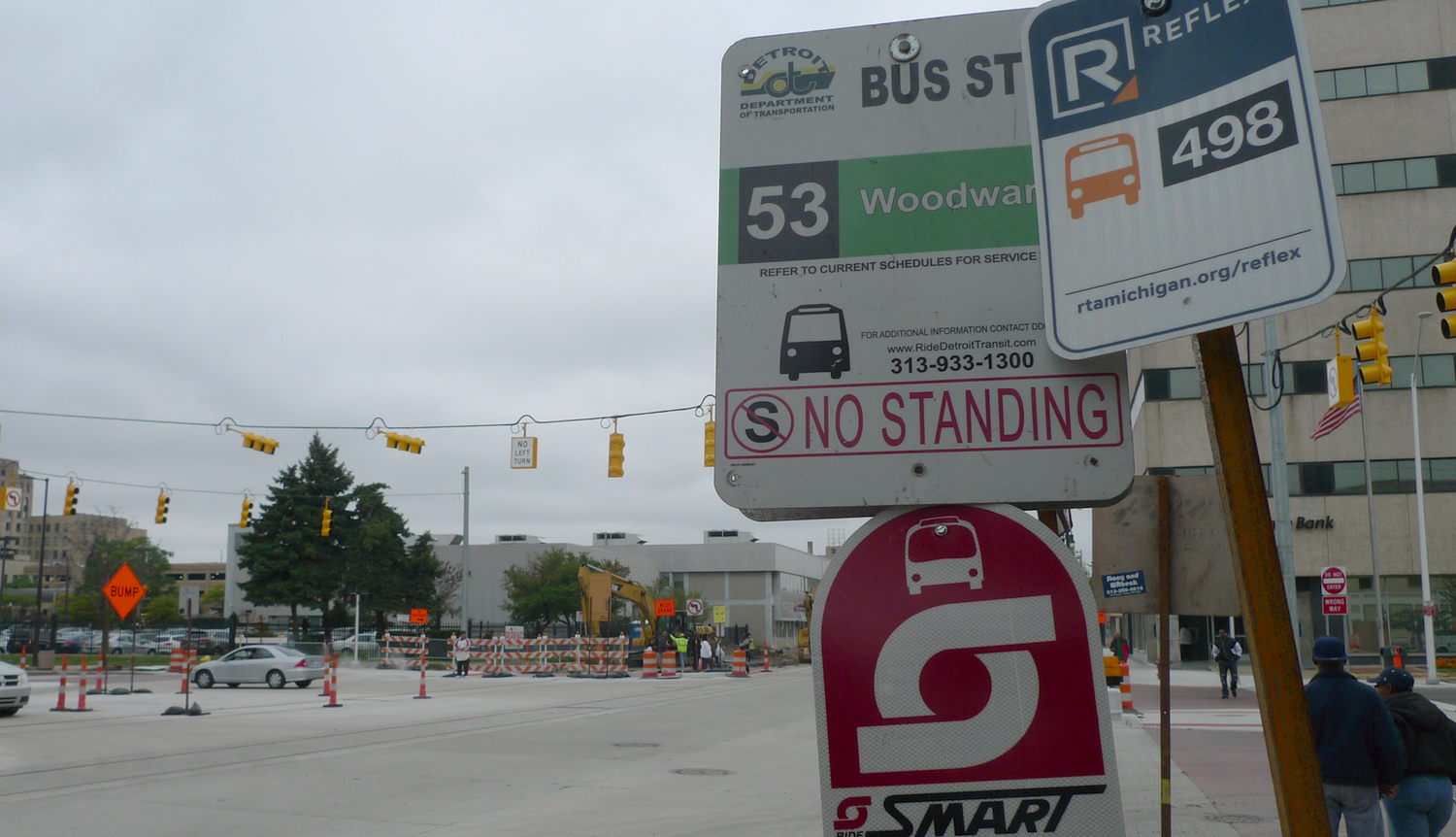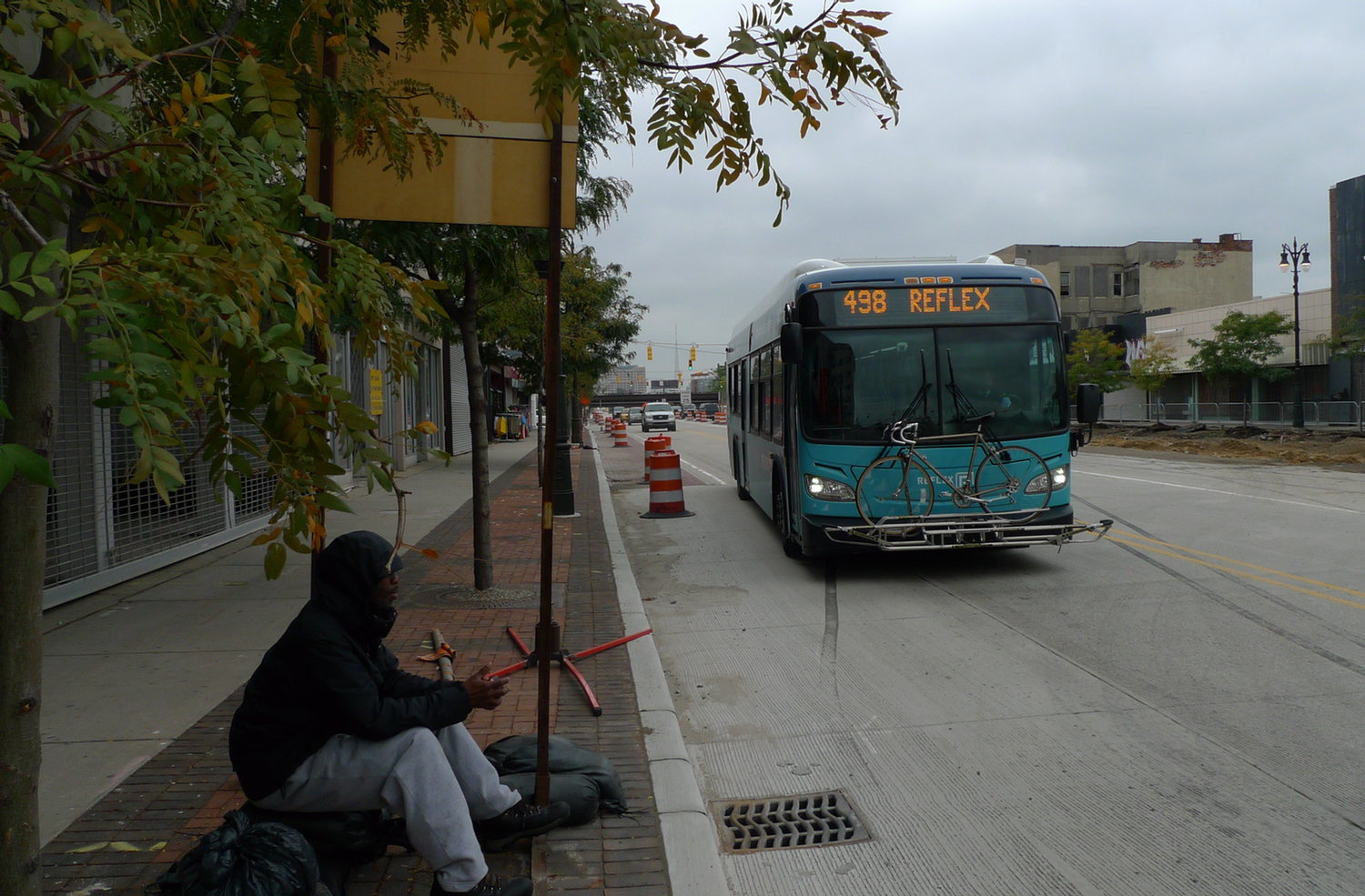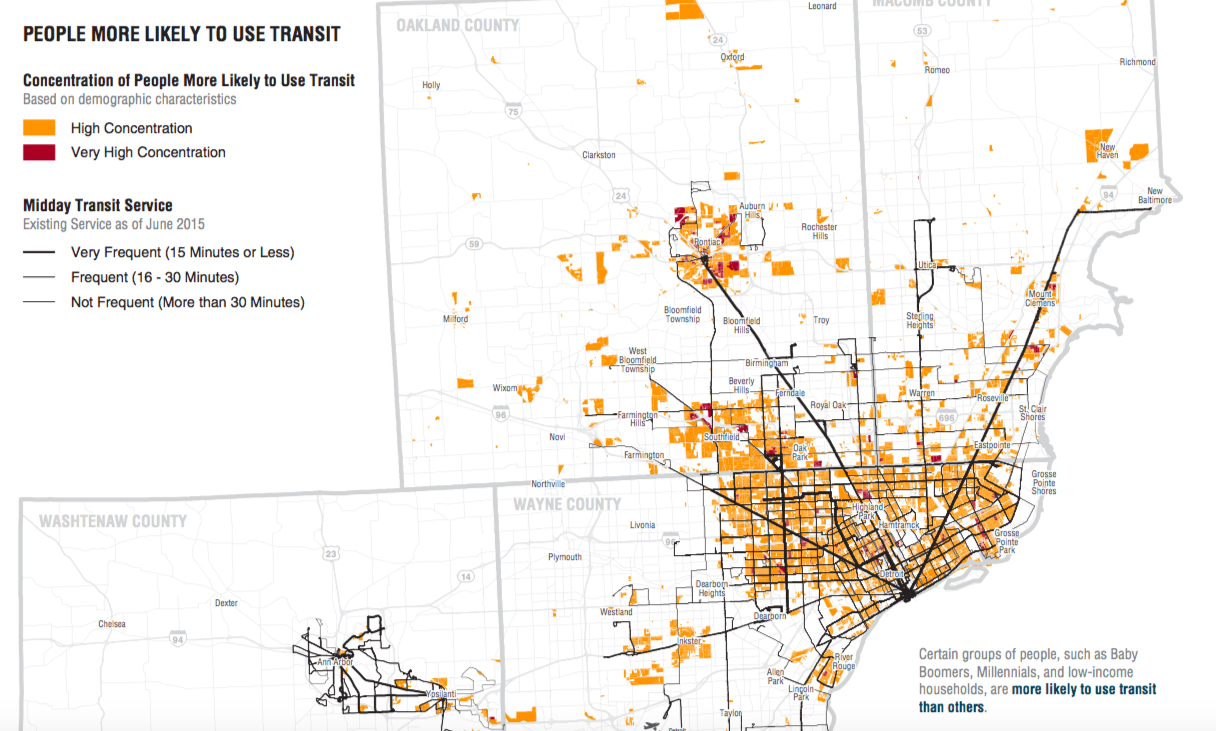Will metro Detroit voters approve mass transit that most will not use?
The two Detroits – the comeback city and the still-stuck one – can see one another across Woodward Avenue at Grand Boulevard.
On one side, New Center, a white-collar employment hub, part of the reawakening comeback. On the other, the North End neighborhood, showing signs of movement toward revival, but with lots of ground yet to cover. But the M-1 Rail tracks are being laid this far north, right down the middle of Woodward, so optimism is called for. And on this overcast day, a knot of Detroit residents are waiting for something residents of other cities take for granted – a bus, one that runs on time, that moves quickly between limited stops, i.e., an express.
In the classic tradition of Detroit mass transit, it’s late. But just by a few minutes.
The RefleX bus, painted a teal blue, branding it as a thing apart from the city and suburban bus systems, pulls up and passengers board. Anyone riding its entire length can travel from just off Campus Martius in downtown Detroit to the Somerset Collection mall, in Troy, stopping 14 times, arriving in an hour, for $1.50.
By Detroit mass-transit standards, this efficient, cross-county trek qualifies as something close to a miracle.
And this is the promise of the Regional Transit Authority, the RTA, birthed by the legislature in 2012 and wobbling to its feet this year, with a master plan that, if approved by voters next month, will bring a coordinated bus system to southeast Michigan after decades of false starts. The RTA plan will make partners of DDOT, Detroit’s city bus service; SMART, the suburban service; AATA, Ann Arbor’s transit service; and, eventually, the M-1 Rail streetcar line along Woodward. The plan pledges to coordinate service in Wayne, Oakland, Macomb and Washtenaw counties -- from low-wage Detroit residents riding to jobs in the suburbs to elderly suburbanites who need to get to the doctor. It would serve the must-ride demographic on one side of Woodward with the more affluent choose-to-ride urbanites on the other, with more crosstown and cross-county fares to carry riders between corridor routes.
It has chambers of commerce on its side, marshalling facts and arguments: Detroit is the largest metro area in the country without regional transit, with longer commutes and workers whose jobs lay by and large outside the city limits.
But what it doesn’t have, yet, is an affirmative vote to fund it.
That comes Nov. 8, when voters in the four counties will decide whether they want to pay a 1.2 mill increase in property tax for the RTA to finally flower as the 24th effort at true regional mass transit in a region that has often been too divided, too hostile, too indifferent or too car-bound to make it a priority.
Including the state and federal funds approval would trigger, the RTA expects the measure to generate $4.7 billion in funding over 20 years. Of that, $3.3 billion will come from the property tax, which would cost a household assessed at $100,000 about $120 more per year.
A business necessity
Dennis Cowan is the former chairman of the Oakland County Republican party and former mayor of Royal Oak. He said he started believing in mass transit during his term as mayor, in the 1990s, when the southern Oakland city was starting to become the nightlife and dining destination it is today. Restaurant owners complained it was too difficult for their employees to get to work. The problem was bad enough that the city helped set up jitney services for them, an imperfect solution.
“I just ran into the head of the (local) restaurant association the other day,” Cowan said. “They have the same problem.”
On the other side stands Leon Drolet, a former state representative from Macomb County and anti-tax activist. He is helping lead organized opposition to the RTA measure, a group calling itself No Massive Transit Tax. The name is a spoiler for his argument.
“We already pay a lot for mass transit,” he said. “There’s already a 1 mill tax in Oakland and Macomb (for SMART, which serves those two counties).” And all for what Drolet calls “very substandard service. To ask us to double what we pay, and give it to the same groups that have failed us, is not a very inspiring proposal.”
And so, as it has so often in the past, the arguments for and against public transit depend on what part of the public you’re talking about. Even its proponents acknowledge that Metro Detroit is not New York City, and that most people will continue to commute via private vehicles.
Kelly Rossman-McKinney, whose Lansing public-relations agency is speaking on behalf of Citizens for Connecting Our Communities, the vote-yes advocates, puts the transit-commuting figure at 12 percent of voters in the four-county area.
But RTA advocates ask voters to consider the possibilities: Not only when busboys and grill cooks can get to Royal Oak on a bus, but when low-income Detroit residents like “walking man” James Robertson, who commuted 23 miles one-way to his job, almost half of them on foot, walk for the exercise, not out of necessity.
And for the remaining 88 percent who don’t currently use mass transit, consider this: A commuter train between Detroit and Ann Arbor. A bus between downtown and Metro Airport, or to a weekend or evening ballgame. Using public transit because it’s easy and convenient, not because you have no other options.
“There’s no doubt in my mind that voters truly recognize (Detroit’s regional transit) is among the worst in the country,” said Rossman-McKinney.
To which critics like Drolet say, have you heard of this thing called Uber?
But what of the cost?
He’s serious. Ride-sharing, now in its infancy with services like Uber and Lyft, is the future of public transit, Drolet said.
“This is a 1980s proposal that will trap us,” he said of the RTA bus proposal. “It anchors us to decades of dinosaur mass transit.”
With driverless cars on the horizon, ride-sharing can do what buses do now, Drolet contends, and perhaps at the same price, if governments stopped subsidizing public transit.
“Of course this couldn’t happen overnight,” he cautioned.
Indeed, those who study mobility management, as it’s called in academic circles, say ride-sharing services like Uber, Lyft and others have a role to play in getting people around metropolitan areas, as part of a “multi-modal” framework of choices.
Ride-shares or driverless cars could help commuters with a piece of the daily commute – getting to or from a bus or rail stop, said Clark Harder, executive director of the Lansing-based Michigan Public Transit Association, which advocates for the state’s urban and rural transit systems.
“It’s popular for anti-transit people to point to Uber and say that’s the answer,” said Harder. “There’s a potential for public transit to work with Uber to help deliver rides for people. But I’m highly doubtful it could ever replace good public transit.”
The people on the bus
Melissa Roy understands the frustration of both sides. As the executive director of Advancing Macomb, a business leadership group, and one of her county’s representatives on the SMART board, she recently found herself without a car -- it was in for repairs -- and vowed to walk the public-transit talk, commuting from her home in downtown Detroit to her office one county away in Mount Clemens.
It isn’t easy, she is the first to note. But Macomb has gone all-in on SMART. Unlike Wayne and Oakland counties, no Macomb communities opt out of the system, she said. (A feature of the SMART system is that it requires affirmative community votes to join and pay for the service, and many Oakland and Wayne communities don’t, leading to a patchwork system that leaves some commuters, like walking man Robertson, out in the cold).
“SMART has overwhelming support, even from the (county’s) northern communities, where they don’t see regular buses. The delivery is good and voters are happy,” Roy said. “Where transit has fallen down is that we have two systems, one focused on one city, the other with a lot of opt-outs.”
Another hurdle to a yes vote was a midsummer balk, by Macomb County Executive Mark Hackel and Oakland County Executive L. Brooks Patterson, at a scheduled RTA board meeting where a vote was scheduled to approve the measure for the November ballot. Hackel and Patterson issued a joint statement claiming the plan would cost more than voters were being told and not deliver services commensurate with its cost to both counties.
The 2012 legislation contained a clause stipulating that 85 percent of RTA monies collected in each county be spent on transit service in that county, seen as critical to getting regional support. The strongest need for better transit is in Detroit, and both men seemed to doubt the suburban counties would get enough value from the deal.
The two said they were satisfied by a compromise hammered out a week later, that stipulated an annual review of spending, to ensure all counties were getting their 85 percent. But neither has come out with strong support for the RTA measure. Hackel spokesman John Cwikla said both were standing neutral, preferring to let the public decide.
Roy said her SMART board service has taught her that transit funding based on property values can be a delicate thing. Following the collapse in property values in the 2000s, the SMART system had to make painful service cuts. If that happens to the RTA, she said, Macomb didn’t want “one part of the region (to be) marginalized. Everybody has skin in the game. This is really the first regional governance structure that has a physical, capital impact on everybody the region. The (Detroit Institute of Arts), the zoo, Cobo all have a specific location. This hits everyone from all standpoints. It’s really important that we do this right. And that we work together as a region.”
Michael Ford, executive director of the RTA, added that “coordination will be a huge cornerstone and mandate,” should the vote succeed. That means that the three transit entities, eventually to be joined by M-1 Rail, the light rail line running up Woodward Avenue, will have to work in sync for the region to prosper. That means not doing away with, for example, the Woodward Avenue DDOT line, but adding services like the cross-county RefleX, to improve the total experience.
If the plan fails to pass in all four counties, the RTA would be seriously diminished, but would be free to try voter approval again, although not until 2018 (the law says that millage requests can only be made in general elections, in presidential or statewide-election years). There really isn’t a Plan B, but Rossman-McKinney said waiting two more years for another regional vote would be a “long, dark time” to rebuild.
Susan Pollay is chairwoman of the RTA’s Citizen Advisory Council and executive director of the Ann Arbor Downtown Development Authority, which is in favor of the RTA. To her, the significance of holding the vote in 2016 shouldn’t be overlooked.
“Next year will be the 50th anniversary of the Detroit riots,” she said, the cataclysmic event that accelerated the atomization of what had been a relatively cohesive metro area, sparking white and middle-class flight and leading directly to the growing impoverishment of the city.
“Wouldn’t it be something if we could pass something that finally starts to bring the region together again,” Pollay said. “That would say something.”
See what new members are saying about why they donated to Bridge Michigan:
- “In order for this information to be accurate and unbiased it must be underwritten by its readers, not by special interests.” - Larry S.
- “Not many other media sources report on the topics Bridge does.” - Susan B.
- “Your journalism is outstanding and rare these days.” - Mark S.
If you want to ensure the future of nonpartisan, nonprofit Michigan journalism, please become a member today. You, too, will be asked why you donated and maybe we'll feature your quote next time!


 A vote to fund the RTA would marry DDOT and SMART, the city and suburban bus services. Those buses, and the RTA’s new RefleX service, all travel along Woodward Avenue. (Bridge photo by Nancy Derringer)
A vote to fund the RTA would marry DDOT and SMART, the city and suburban bus services. Those buses, and the RTA’s new RefleX service, all travel along Woodward Avenue. (Bridge photo by Nancy Derringer) The teal color of the RTA RefleX brands it as a thing apart from other bus lines running along Woodward. (Bridge photo by Nancy Derringer)
The teal color of the RTA RefleX brands it as a thing apart from other bus lines running along Woodward. (Bridge photo by Nancy Derringer) The RTA pegs baby boomers, millennials and low-income households as the most likely users of public transit. (RTA graphic)
The RTA pegs baby boomers, millennials and low-income households as the most likely users of public transit. (RTA graphic)